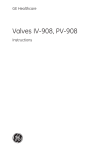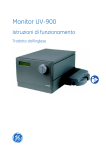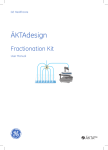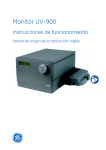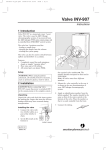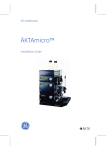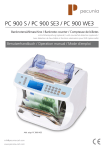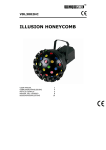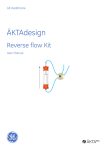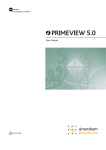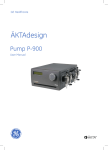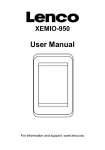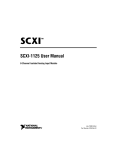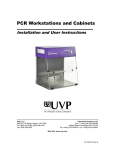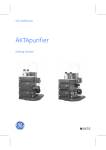Download Monitor UV-900 - GE Healthcare Life Sciences
Transcript
18112005ny.book Page 1 Wednesday, November 9, 2005 10:47 AM GE Healthcare Monitor UV-900 User Manual ÄKTA ™ 18112005ny.book Page 2 Wednesday, November 9, 2005 10:47 AM 18112005ny.book Page 3 Wednesday, November 9, 2005 10:47 AM Important user information All users must read this entire manual to fully understand the safe use of Monitor UV-900. WARNING! CAUTION! The WARNING! sign highlights instructions that must be followed to avoid personal injury. It is important not to proceed until all stated conditions are met and clearly understood. The Caution! sign highlights instructions that must be followed to avoid damage to the product or other equipment. It is important not to proceed until all stated conditions are met and clearly understood. Note The Note sign is used to indicate information important for trouble-free and optimal use of the product. CE Certifying This product meets the requirements of applicable CEdirectives. A copy of the corresponding Declaration of Conformity is available on request. The CE symbol and corresponding declaration of conformity, is valid for the instrument when it is: – used as a stand-alone unit, or – connected to other CE-marked GE Healthcare instruments, or – connected to other products recommended or described in this manual, and – used in the same state as it was delivered from GE Healthcare except for alterations described in this manual. Recycling This symbol indicates that the waste of electrical and electronic equipment must not be disposed as unsorted municipal waste and must be collected separately. Please contact an authorized representative of the manufacturer for information concerning the decommissioning of equipment. WARNING! This is a Class A pruduct. In a domestic environment this product may cause radio interference in which case the user may be required to make adequate measures Monitor UV-900 User Manual 18-1120-05 Edition AF 18112005ny.book Page 4 Wednesday, November 9, 2005 10:47 AM 18112005ny.book Page V Wednesday, November 9, 2005 10:47 AM Contents 1 Introduction 1.1 General ................................................................................................7 1.2 Safety ...................................................................................................8 2 Installation 2.1 Unpacking ..........................................................................................9 2.2 General precautions .....................................................................9 2.3 Installing the flow cell ................................................................ 10 2.3.1 Fixing the flow cell .................................................................... 10 2.3.2 Connecting the optical fibers ............................................... 11 2.4 Connecting electrical signal cables .................................... 12 2.4.1 Connecting to recorder (if used).......................................... 12 2.5 Connecting to communication link ..................................... 12 2.6 Connecting to supply voltage ............................................... 13 2.7 Connecting the tubing .............................................................. 13 2.8 Mounting the cell holder cover ............................................. 14 3 Operation 3.1 On/off ................................................................................................ 15 3.2 Menu selection and settings .................................................. 15 3.2.1 Menu selection ........................................................................... 15 3.2.2 Return to main menu .............................................................. 16 3.2.3 Select value.................................................................................. 16 3.3 Main menu overview ................................................................. 17 3.4 Setting lamp on/off ..................................................................... 17 3.5 Reading absorbance values ................................................... 18 3.6 Setting wavelength ..................................................................... 18 3.7 Autozero .......................................................................................... 19 3.8 Storage and shut-down ........................................................... 19 3.9 Using an external chart recorder ........................................ 20 3.9.1 Setting range and zero ........................................................... 20 3.9.2 Event mark ................................................................................... 20 3.10 Filtering noise ................................................................................ 21 3.11 UV cell calibration ....................................................................... 22 3.12 Changing flow cell ....................................................................... 24 3.13 Restart after power failure ...................................................... 24 4 Maintenance 4.1 Periodic maintenance ............................................................... 25 Monitor UV-900 User Manual 18-1120-05 Edition AF V 18112005ny.book Page VI Wednesday, November 9, 2005 10:47 AM Contents 4.2 4.3 4.3.1 4.3.2 4.3.3 4.3.4 4.4 4.4.1 4.4.2 4.4.3 4.5 4.6 5 Cleaning-in-place .........................................................................25 Checking the instrument ..........................................................26 Lamp intensity ............................................................................26 Lamp on–time .............................................................................26 Flip time..........................................................................................26 UV flow cell ...................................................................................26 Cleaning the flow cell and optical fiber connectors ....27 Cleaning the flow cell...............................................................27 Cleaning the optical fiber connectors ...............................27 Instrument housing...................................................................27 ..................................................................Cleaning the system 27 Recycling ..........................................................................................28 Trouble-shooting 5.1 General .............................................................................................29 5.2 Faults and actions .......................................................................29 5.3 Error messages .............................................................................30 Reference information A Description ........................................................................................................ 31 A.1 A.2 A.3 Instrument ............................................................................................................31 Flow cell .................................................................................................................32 Monitor principle ................................................................................................32 B Menus .................................................................................................................. 34 C D Technical specifications ............................................................................. 39 Accessories and spare parts .................................................................... 42 B.1 B.2 B.3 B.4 B.5 Check menu .........................................................................................................34 Setup menu ..........................................................................................................36 Setting and using the alarm timer .............................................................37 Service displays ..................................................................................................37 Menu overview ...................................................................................................38 Short instructions on side 39 About this manual This manual comprises two parts; a practical part (sections 1–5) and a reference part (sections A-D). Sections 1–5 contain the necessary information for operating the instrument. VI Monitor UV-900 User Manual 18-1120-05 Edition AF 18112005ny.book Page 7 Wednesday, November 9, 2005 10:47 AM 1 Introduction 1 Introduction 1.1 General Monitor UV-900 is a UV-absorption monitor for use in liquid chromatography. Monitor UV-900 features: • Variable wavelength for detection in the range 190–700 nm. • Up to 3 wavelengths can be monitored simultaneously. • Two alternative flow cells with path length 2 mm and 10 mm. • Accurate and reliable monitoring through self-test, self-calibration and fiber optics. Monitor UV-900 Monitor UV-900 User Manual 18-1120-05 Edition AF 7 18112005ny.book Page 8 Wednesday, November 9, 2005 10:47 AM 1 Introduction 1.2 Safety IMPORTANT! Monitor UV-900 is intended for laboratory use only, not for clinical or in vitro use, or for diagnostic purposes. • • The instrument is designed for indoor use only. Do not use in a dusty atmosphere or close to spraying water. WARNING! When using hazardous chemicals, all suitable protective measures, such as protective glasses, must be taken. WARNING! The instruments must not be opened by the user. They contain high voltage circuits which can give a lethal electric shock. WARNING! The system must be connected to a grounded mains socket. WARNING! Always disconnect the power supply before attempting to replace any item on the instrument. WARNING! The instrument uses high intensity ultra-violet light. Do not disconnect the optical fibers while the monitor is running. CAUTION! The flow cell must not be used at pressures above 2 MPa (20 bar, 290 psi). At higher pressures the flow cell may break. WARNING! When using hazardous chemicals, take all suitable protective measures, such as wearing protective glasses and gloves resistant to the chemicals used. Follow local regulations and instructions for safe operation and maintenance of the system. WARNING! There must always be a sample loop connected to ports 2 and 6 of the injection valve. This is to prevent liquid spraying out of the ports when switching the valve. This is especially dangerous if hazardous chemicals are used. WARNING! This is a Class A product. In domestic environment this product may cause radio interference in which the user may be required to take adequate measures. 8 Monitor UV-900 User Manual 18-1120-05 Edition AF 18112005ny.book Page 9 Wednesday, November 9, 2005 10:47 AM 2 Installation 2 Installation 2.1 Unpacking Unpack the instrument and check the items against the supplied packing list. Inspect the items for obvious damage which may have occurred during transportation. • The system should be installed on a stable laboratory bench providing a suitable working area. • To maintain correct ventilation, the system requires an appropriate amount of free space. Do not block the ventilation inlets or outlets on the system! It is recommended that all packing materials should be retained if onward transport of the instrument is expected. CAUTION! The following information should be read carefully to ensure that the instrument is installed correctly. 2.2 General precautions The instrument should not be installed in a corrosive atmosphere or in an atmosphere where deposits are liable to form on the optical surfaces. The instrument should be located in a place of low temperature variations, away from heat sources, draughts and direct sunlight. The instrument may be operated at normal ambient temperatures in the range +4 to +40 °C. Monitor UV-900 The instrument should be installed on a stable laboratory bench or in ÄKTA™ explorer or ÄKTApurifier. To ensure correct ventilation a free space of 0.1 m is required behind and in front of the instrument. Place the instrument directly on the bench. Do not use any soft material under the instrument, to ensure that the ventilation inlet in the front is not blocked. Monitor UV-900 User Manual 18-1120-05 Edition AF 9 18112005ny.book Page 10 Wednesday, November 9, 2005 10:47 AM 2 Installation 2.3 Installing the flow cell 2.3.1 Fixing the flow cell Handle the optical fibers with care, do not bend excessively. Two flow cells are available: UV-900/2 with 2 mm light path length (cell volume 2 µl) and UV-900/10 with 10 mm path length (8 µl). 10 mm 2 mm 1 Unpack the flow cell. Do not remove the red protective caps from the inlet or outlet, or the black protective caps on the optical fiber connectors. 2 Slide the rear white clip on the cell holder to its inner position for a 2 mm cell and to its outer position for the 10 mm cell. 3 Place the flow cell in the opening between the white clips. The cell should be positioned with the text and serial number facing upwards and to the front. Press the cell into the clips to fasten it. CAUTION! To avoid damaging the optical fibers, press only on the cell body, never on the optical fibers. 10 Monitor UV-900 User Manual 18-1120-05 Edition AF 18112005ny.book Page 11 Wednesday, November 9, 2005 10:47 AM 2 Installation To improve the access to the tubing connections, the flow cell can alternatively be positioned with the tubing connections. Normal position Alternative position Serial number 2.3.2 Serial number Connecting the optical fibers 1 Remove the 2 black protective caps from the optical fiber connectors. CAUTION! Do not touch the tips of the optical fibers with your fingers as this will result in poor monitor performance. If you accidentally touch the optical fiber tip, it can be wiped with 30% isopropanol using lens paper. 2 Remove the 2 rubber protective caps from the optical fiber receptacles on the right side of the housing. Fiber detachment tool 3 Connect the 2 optical fibers to the housing by carefully inserting them into the sockets and tightening the nuts fingertight using the fiber detachment tool supplied. CAUTION! Do not twist the optical fibers during tightening. Rubber sleeve 4 Slide the rubber sleeves on the 2 optical fibers onto the connectors. Make sure that the sleeves are pushed tight to the housing to prevent dust or fluid entering the connection. Monitor UV-900 User Manual 18-1120-05 Edition AF 11 18112005ny.book Page 12 Wednesday, November 9, 2005 10:47 AM 2 Installation 2.4 Connecting electrical signal cables The sockets for electrical signals are located on the back panel. Analogue out Remote UniNet 1 0-1V 2.4.1 Mains On/off Connecting to recorder (if used) 1 Connect the recorder to the miniDIN-socket Analogue out using the cable supplied. Each wavelength signal is available on a separate channel using the following wires: λ1 λ2 λ3 Note: Wire 1 + Wire 2 – Wire 3 + Wire 4 Wire 5 + Wire 6 The signal cable is delivered with protective covers on each wire. Do not remove the protective covers from unused connections as a short circuit may disturb the measurements. 2 Set the recorder to 0–1 V input, full scale, 0 V offset. 2.5 Connecting to communication link The monitor can be used in ÄKTAexplorer or ÄKTApurifier and controlled from a PC running UNICORN™ version 3.21 or higher, using UniNet cables. CAUTION! The mains power to the ÄKTAexplorer or ÄKTApurifier must be switched OFF before connecting the instrument to the UniNet-1 link. WARNING! Only use mains cables delivered or approved by GE Healthcare. WARNING! Do not block the rear panel of the system. The mains power switch must always be easy to access. 12 Monitor UV-900 User Manual 18-1120-05 Edition AF 18112005ny.book Page 13 Wednesday, November 9, 2005 10:47 AM 2 Installation Connect two UniNet cables to the UniNet-1 connectors. The instrument can be connected in series anywhere in the chain between the PC and the termination plug. The UniNet-1 link connects, in series, the PC with Pump P-905, Monitor pH/C-900 and Monitor UV-900. The termination plug is connected to the last instrument in the chain. 2.6 Connecting to supply voltage 1 Make sure the on/off switch is in the OFF position (O). 2 Connect a mains cable between the instrument and a grounded mains socket. The instrument is delivered with both European and US type mains cables, as standard. Any voltage 100–240 V AC, 50–60 Hz, can be used. WARNING! The instrument must be connected to a grounded mains socket. The instrument contains no user replaceable fuse. 2.7 Connecting the tubing 1 Remove the red protective caps from the inlet and outlet of the flow cell and connect the tubing with 1/16" “fingertights”. Inlet Outlet The inlet is on the top of the flow cell, the same side as the serial number. Monitor UV-900 User Manual 18-1120-05 Edition AF 13 18112005ny.book Page 14 Wednesday, November 9, 2005 10:47 AM 2 Installation 2.8 Mounting the cell holder cover The cover is a simple push fit onto the cell holder. Two small lugs on the cover locate in holes at the front and rear of the cell holder The cover is then lowered over the cell holder. Monitor UV-900 User Manual 18-1120-05 Edition AF 14 18112005ny.book Page 15 Wednesday, November 9, 2005 10:47 AM 3 Operation 3 Operation Selftest Please wait... Calibrating Please wait... Please Check UV Cell! Press OK/Esc to cont. Real UV Cell Length (?,??mm, SN?????? 3.1 On/off 1 Switch on the instrument at the mains switch on the rear panel. 2 The instrument performs a self-test and then starts calibration. 3 If the instrument has a calibrated cell path length set that differs from the nominal length, a warning message appears on the monitor display. Another message, displaying the calibrated cell length, also appears. The display toggles between these messages. 4 To go to the Main operating menu, press OK or wait for about 45 seconds to return automatically. λ1(215) λ2(254) 1.123 AU 0.02345 AU 5 If no such warning messages appear, the display automatically shows the Main operating menu after approximately 1 minute. The instrument is ready to use. All parameters are factory set to default values. 3.2 Menu selection and settings 3.2.1 Menu selection A specific menu is selected by turning the front selection dial clockwise or counter clockwise. When the required menu is visible the menu or selection is accepted by pressing the OK button. Menu selection Monitor UV-900 User Manual 18-1120-05 Edition AF OK button Select submenu ESC button Return one menu level 15 18112005ny.book Page 16 Wednesday, November 9, 2005 10:47 AM 3 Operation If a menu has sub levels, the sub menu is displayed by pressing the OK button. Pressing the ESC button moves back one menu level. Main menus Sub menus Sub menus Main menu 1 Main menu 2 OK Sub menu 3.1 Main menu 3 OK Sub menu 3.1.1 ESC ESC Main menu 4 Sub menu 3.2 Main menu 5 Sub menu 3.3 OK Sub menu 3.3.1 ESC Sub menu 3.3.2 3.2.2 Return to main menu Pressing ESC repeatedly, always returns to the main menu 2 which is the main operating menu. Press ESC once more to return to main menu 1, the mode changing menu. Main menu 1 ESC ESC Main menu 2 3.2.3 ESC ESC ESC Select value A cursor below a text or numerical value shows what is affected by the dial. To increase the value turn the dial clockwise. To decrease the value turn the dial counter clockwise. Parameter Current value Set Wavelength (280 nm) 250.0 New value to be set When setting numerical values, the cursor moves up to the next digit if the dial is turned quickly in one direction, to simplify entering large values. The cursor moves back one place to the right every two seconds if the dial is not turned. The text or numerical value displayed is accepted by pressing the OK button. To cancel, press the ESC button. 16 Monitor UV-900 User Manual 18-1120-05 Edition AF 18112005ny.book Page 17 Wednesday, November 9, 2005 10:47 AM 3 Operation Run Press OK to End λ1(215) λ2(254) 1.123 AU 0.02345 AU λ3(280) 1.123 AU Autozero Produce event mark. Eventmark Set Wavelength (215, 254, 280 nm) Set Analogue Out (2.000AUFS, 10%) Set Averaging Time (2,56s) Set UV Cell Length (--.-- mm, SN ------) Check Setup Alarm/Timer 00:22:24 Set the wavelengths for the measurements. Set the recorder output . Filtering noise. Flow cell path length calibration. Check internal operating values. See section B.1 Check menu. Setup language, unit number etc. See section B.2 Setup menu. Set different timer options. See section B.3 Setting and using the alarm timer. 3.4 Setting lamp on/off The lamp should be switched off when no measurement is made to conserve the lamp operating time. The lamp is switched on when a run is started. No warm-up time is required. Current status Run Press OK to 3.3 Main menu overview Mode changing menu (mode menu).The menu is accessed from all positions by pressing the ESC button repeatedly. Main operating menu 1. Wavelength display showing first two wavelengths and, if the instrument is in Run mode, their absorbance. Main operating menu 2. Wavelength display showing the third wavelength and, if the instrument is in Run mode, the absorbance. Autozero the instrument. End 1 Select the mode changing menu. 2 Switch the lamp on (Run) or off (End) by pressing OK . Its current status is shown in the upper left of the display. When controlled from UNICORN, the lamp is switched on automatically when the flow is started and off when the run is ended. Monitor UV-900 User Manual 18-1120-05 Edition AF 17 18112005ny.book Page 18 Wednesday, November 9, 2005 10:47 AM 3 Operation λ1(215) λ2(254) 1.123 AU 0.02345 AU λ3(280) 1.123 AU 3.5 Reading absorbance values The main operating menu shows the absorbance values for up to 3 active wavelengths. The menu is reached from any other menu by pressing the ESC button repeatedly. The display for the third wavelength is reached by turning the dial clockwise. or 215nm 1.123 254nm 280nm 0.023 0.123 As an alternative all 3 wavelengths can be shown in a single display, but limited to 3 decimals. This alternative is reached by turning the dial clockwise. 3.6 Setting wavelength The instrument can measure up to 3 wavelengths simultaneously and wavelength changes can be set at any time. Set Wavelength (215, 254, 280 nm) Set Wavelength λ1 (215, 254, 280 nm) Set Wavelength λ1 (215nm) 234 Set Wavelength λ2 (254nm) 1 Select main menu Set Wavelength, press OK. 2 Select sub menu Set Wavelength λ1, press OK . 3 Set the value, press OK. 4 The next wavelength λ2 is now shown. Set the value or turn the wavelength off, by turning the dial counter clockwise until the value passes through 190 nm. If only one wavelength is to be used, λ2 and λ3 should be set to off. Press OK. The first wavelength λ1 can never be set to off. 5 Repeat step 4 in the menu Set Wavelength λ3. 6 Press ESC to return to the main operating menu. In UNICORN, the wavelengths are set with the instruction Wavelength in System Control:Manual:Alarm&Mon. 18 Monitor UV-900 User Manual 18-1120-05 Edition AF 18112005ny.book Page 19 Wednesday, November 9, 2005 10:47 AM 3 Operation 3.7 Autozero The autozero function sets the detected absorbance to zero when the OK button is pressed. All three wavelengths are autozeroed. Autozero is recommended after wavelength changes in a method and before the sample is injected. Autozero 1 Select main menu Autozero, press OK. The normal absorbance value display is then shown. In UNICORN, Autozero is set with the instruction AutoZeroUV in System Control:Manual:Alarm&Mon. 3.8 Storage and shut-down Overnight: The flow cell can be left filled with buffer. Weekend and long term storage: Flush the flow cell with distilled water and then fill it with 20% ethanol. The flow cell can also be stored dry by flushing as above with distilled water and then blowing a compressed inert gas such as nitrogen (N2) through the cell. Replace the red protective caps. Never use compressed air as this may contain droplets of oil. CAUTION! Do not allow solutions which contain dissolved salts, proteins or other solid solutions to dry out in the flow cell. Do not allow particles to enter the flow cell as damage to the flow cell may occur. Monitor UV-900 User Manual 18-1120-05 Edition AF 19 18112005ny.book Page 20 Wednesday, November 9, 2005 10:47 AM 3 Operation 3.9 Using an external chart recorder 3.9.1 Setting range and zero The external chart recorder output from the instrument is always 0–1 V, but the absorbance value for full scale deflection and the Zero Absorbance level on the recorder can be set. 1 Select main menu Set Analogue Out , press OK . Set Analogue Out (2.000AUFS, 10%) Set Range (2.000AUFS) Set Zero Level (10% of FS) <0.1> 2 Set the range value in the sub menu Set Range and press OK. The range is the full scale absorbance range for the chart recorder (1 V). Only fixed steps between 5.0 AU and 0.01 AU can be set and the value is the same for all 3 wavelengths. 3 Select menu Set Zero Level, press OK. 20 4 Set the value and press OK. This value determines where the zero absorbance level should be in relation to full scale on the recorder. The instrument has an automatic overrange function. If during a peak the monitor signal reaches the full scale value, the signal will drop instantly to 0 V and give an accurate display of the peak starting from this position. 3.9.2 Range AU Overrange Event mark Event marks can be set, for example when the sample is injected, and displayed as spikes on all three channels of the chart recorder. The spikes are 10% of the full scale of the chart recorder which corresponds to 0.1 V. 1 Select main menu Event mark, press OK . 20 Measured absorbance level (A U) Signal to recorder (V) 1V 0V Monitor UV-900 User Manual 18-1120-05 Edition AF 18112005ny.book Page 21 Wednesday, November 9, 2005 10:47 AM 3 Operation 3.10 Filtering noise To filter the noise in the UV-signal, a moving average filter is used. The averaging time is the time interval used for calculating the moving average of the absorbance signal. A long averaging time will smooth out noise efficiently, but it will also distort the peaks. Peaks narrower than the minimum peak width value may be distorted. Because of this the averaging time should be as short as possible, see the table below. On delivery the averaging time is set to 2.56 s. 1 Select menu Set Averaging Time, press OK. Set Averaging Time (2.56s) <2.56> 2 Set the value, press OK. Use the fixed values between 5.12 and 0.08 s. When monitoring more than one wavelength, the recommended averaging time is a minimum of 1.28 s. Averaging time (s) 5.12 2.56 1.28 0.64 0.32 0.16 0.08 Time constant (s) (approximate) 2.0 1.0 0.5 0.2 0.1 0.05 0.03 Min. peak width at half height (s) 32 16 8.0 3.2 1.6 0.8 0.5 In UNICORN the averaging time is set with the instruction AveragingTime in System Control:Manual:Alarm&Mon. Monitor UV-900 User Manual 18-1120-05 Edition AF 21 18112005ny.book Page 22 Wednesday, November 9, 2005 10:47 AM 3 Operation 3.11 UV cell calibration The path length in the UV flow cell might differ from the nominal length (1, 2, 5 respective 10 mm) which interferes the calculation of the protein concentration in the eluate. To achieve normalized absorbance, the path length in the UV flow cell must be calibrated. It is recommended to calibrate a new UV flow cell before use. An old flow cell can be calibrated whenever you think that a calibration is required. Equipment required To perform the calibration you need test solutions, syringes and accessories for desired cell length: • UV-900 1 mm Calibr. kit, no. 18-6324-01 • UV-900 2 mm Calibr. kit, no. 18-6324-02 • UV-900 5 mm Calibr. kit, no. 18-6324-04 • UV-900 10 mm Calibr. kit, no. 18-6324-05 To calculate the real cell length use the supplied Excel-file: • Please Check UV Cell! Press OK/Esc to cont. Real UV Cell Length (?,??mm, SN?????? Removing an old calibration setting If the instrument already has a calibrated cell length set that differs from the nominal length, a warning message appears on the UV monitor display at start-up. Another message, displaying the calibrated cell length, also appears. The display toggles between these messages. The display automatically returns to the main operating menu after about 45 seconds, or if pressing OK. 1 To remove an old calibration value, press Esc while the display toggles between the two messages. The Set UV Cell Length menu appears. Press OK. Set UV Cell Length (--,--mm, SN------) Set Calibr. Length (--,--mm) UV-900 Cell Calibr. Excel-file, no. 18-6324-06 2 At the Set Calibr. Length menu, set the cell length to 0. Press OK. --.-- Preparing the calibration 1 Remove any old calibration value by setting the cell length to 0 (see above). 2 Unpack the UV Test kit. Union 3 Make sure that the Flow restrictor is connected in the flow path after the UV flow cell. 4 Mount the Union Luer female/ 1/16" male, included in the test kit, in the upper inlet of the UV flow cell. 22 Monitor UV-900 User Manual 18-1120-05 Edition AF 18112005ny.book Page 23 Wednesday, November 9, 2005 10:47 AM 3 Operation 5 Open the UV-900 Cell Calibr. Excel-file on the computer. 6 The solution bottles are marked with the concentration value and the reference absorbance value for each solution. Enter the concentration of the solutions in increasing order in the column UV Test kit Concentration (mg/l). Enter the absorbance value in increasing order in the column UV Test kit Absorbance (AU/cm). Performing the absorbance measurements For each of the four test solutions, the absorbance will be measured and automatically compared to its reference value. WARNING! When using hazardous chemicals, take all suitable protective measures, such as wearing protective glasses and gloves resistant to the chemicals used. Follow local regulations and instructions for safe operation and maintenance of the system. WARNING! Sulfuric acid included in the test soluitons is injurious to health. Avoid spillage and use eye protection. 1 Switch on the UV lamp, see 3.4 Setting lamp on/off. 2 Select a main menu on the monitor display that shows wavelength 254 nm. 3 Fill one of the supplied syringes with 1.5–2 ml of the 0 AU/cm solution. Make sure that there is no air in the syringe! 4 Fit the syringe in the Union Luer connector and inject the solution. Do NOT remove the syringe. 5 Wait until the monitored absorbance value is stable. 6 Perform an Autozero operation. See section 3.7 Autozero. Monitor UV-900 User Manual 18-1120-05 Edition AF 23 18112005ny.book Page 24 Wednesday, November 9, 2005 10:47 AM 3 Operation 7 Remove the syringe. 8 Inject the other four test solutions in increasing concentration order. Use a new syringe for each solution. Note: Air trapped in the UV cell causes inaccurate measurements. To avoid introducing air into the cell, gently fill the Luer union up to the edge using test solution from the syringe that is next. Then insert the syringe into the Luer union. 9 After each injection, wait for a stable absorbance value and enter the measured values in the column UV -900 Absorbance (AU) in the UV-900 Cell Calibr. Excel-file. 10 When all absorbance values have been entered, the real cell length is shown next to the Real cell length square. Note: The regressions coefficient should be larger than 0.999. If not, one or several measured values are faulty. Entering the new real length 1 Select menu Set UV Cell Length in the UV monitor. Press OK. The Set Calibr. Length menu appears. Press OK. Set UV Cell Length (--,--mm, SN------) Set Calibr. Length (--,--mm) 2 Enter the Real cell length value (from the Excel-file) and press OK . --.-- 3 The Set UV Cell Type menu appears. Check the cell type value. Set UV Cell Type (2 mm) If the value is correct, turn the selection dial clockwise to go to next menu. If the value has to be changed, press OK to change it. 4 At the Set Cell Serial No. menu press OK. Set Cell Serial No. (SN ------) 5 Enter the serial number of the cell (see the label on the flow cell). Press OK . ------ 3.12 Changing flow cell The flow cell can be changed when required, for example from 2 mm to 10 mm when the sensitivity of the measurement must change due to a small amount of sample being applied, or from a 10 mm to 2 mm when a lower sensitivity is desired, due to output signal limitation. See section 2.3 Installing the flow cell. 3.13 Restart after power failure If the power supply to the instrument is interrupted, the instrument automatically restarts itself and displays the main operating window. All set values are retained in the instrument but the instrument starts with the lamp switched-off. 24 Monitor UV-900 User Manual 18-1120-05 Edition AF 18112005ny.book Page 25 Wednesday, November 9, 2005 10:47 AM 4 Maintenance 4 Maintenance WARNING! Always disconnect the power supply before attempting to replace any item on the system during maintenance. WARNING! Only spare parts that are approved or supplied by GE Healthcare may be used for maintaining or servicing the system. 4.1 Periodic maintenance Interval Every 3 month Every 6 month or more often if required Action (see procedures below) Check the instrument Clean the flow cell and optical fiber connectors WARNING! Remove liquid or dirt from the system surface using a cloth and, if necessary, a mild cleaning agent. WARNING! When using hazardous chemicals, take all suitable protective measures, such as wearing protective glasses and gloves resistant to the chemicals used. Follow local regulations and instructions for safe operation and maintenance of the system. WARNING! When using hazardous chemicals, make sure that the entire system has been flushed thoroughly with bacteriostatic solution, e.g. NaOH, and distilled water before service and maintenance. 4.2 Cleaning-in-place Pump a cleaning or sanitizing agent through the flow cell. The standard recommendation is to pump 1 M NaOH at 1 ml/min for 30 minutes and then wash out with buffer. WARNING! NaOH is injurious to health. Avoid spillage. Monitor UV-900 User Manual 18-1120-05 Edition AF 25 18112005ny.book Page 26 Wednesday, November 9, 2005 10:47 AM 4 Maintenance Check Lamp Intensity 210nm 85% 300nm 95% 4.3 Checking the instrument 4.3.1 Lamp intensity 1 Select menu Check, press OK . 2 Select menu Check Lamp Intensity. If the lamp intensity is < 20%, contact GE Healthcare for lamp replacement or change of internal optical fiber. 4.3.2 Check Lamp Run Time 200h Lamp on–time 1 Select menu Check, press OK. 2 Select menu Check Lamp Run Time. If the lamp ontime is > 4000 hours, contact GE Healthcare for lamp replacement. 4.3.3 Flip time The flip time is the time the monochromator stepper motor has been in operation. 1 Select menu Check, press OK . Check Flip Time 50h 2 Select menu Check Flip Time. If the flip time is > 2000 hours, contact GE Healthcare for maintenance. 4.3.4 UV flow cell This menu shows the set path length and the serial number of the UV flow cell. 1 Select menu Check and press OK. UV Flow Cell (--,--mm, SN -----) 2 Select menu UV Flow Cell. Monitor UV-900 User Manual 18-1120-05 Edition AF 26 18112005ny.book Page 27 Wednesday, November 9, 2005 10:47 AM 4 Maintenance 4.4 Cleaning the flow cell and optical fiber connectors A clean flow cell and optical connectors are essential for ensuring the correct operation of the UV-monitor. CAUTION! Do not allow solutions containing dissolved salts, proteins or other solid solutes to dry out in the cell. Do not allow particles to enter the flow cell as damage to the flow cell may occur. 4.4.1 Cleaning the flow cell 1 Connect a syringe to the inlet of the flow cell and squirt distilled water through the cell in small amounts. Then fill the syringe with a 10% surface active detergent solution like Decon 90, Deconex 11, RBS 25 or equivalent, and squirt five times. 2 After five squirts, leave the detergent solution in the flow cell for at least 20 minutes. 3 Pump the remaining detergent solution through the flow cell. 4 Rinse the syringe and flush the cell with distilled water (10 ml). 4.4.2 Cleaning the optical fiber connectors Wipe with 30% isopropanol on lens paper. 4.4.3 Instrument housing WARNING! When using hazardous chemicals, make sure that the entire system has been flushed thoroughly with bacteriostatic solution, e.g. NaOH, and distilled water before service and maintenance. 4.5 Cleaning the system • Wipe the surface regularly with a damp cloth. Do not allow spilt liquid to dry on the instrument. • Remove dirt from the surface using a cloth and a mild cleaning agent. • Let the system dry completely before using it. Wipe the instrument housing regularly with a damp cloth. Let the instrument dry completely before use. Monitor UV-900 User Manual 18-1120-05 Edition AF 27 18112005ny.book Page 28 Wednesday, November 9, 2005 10:47 AM 4 Maintenance 4.6 Recycling This symbol indicates that the waste of electrical and electronic equipment must not be disposed as unsorted municipal waste and must be collected separately. Please contact an authorized representative of the manufacturer for information concerning the decommissioning of equipment 28 Monitor UV-900 User Manual 18-1120-05 Edition AF 18112005ny.book Page 29 Wednesday, November 9, 2005 10:47 AM 5 Trouble-shooting 5 Trouble-shooting Monitor UV-900 V1.06 5.1 General When contacting GE Healthcare for support, state the program version of the instrument, which is shown for 2 seconds after the self-test, during switch-on, or in the menu Check Service Mode, see page 35. WARNING! The instruments must not be opened by the user. They contain high voltage circuits which can give a lethal electric shock. 5.2 Faults and actions If the suggested actions do not correct the fault, call GE Healthcare. Fault Possible cause No text on the front display No power to the monitor Noisy UV-signal, signal drift The buffer may be impure or instability There may be air in the flow cell Ghost peaks Air in the eluents Dirt or residues in the flow path from previous runs Residues in the column from previous runs Bad mixing of the eluents Error in external chart recorder The recorder not properly set up Monitor UV-900 not properly set up Monitor UV-900 User Manual 18-1120-05 Edition AF Corrective action Check that the mains cable is connected and the power switch is in ON-position I Check if the signal is still noisy with water Check that the flow restrictor gives a back pressure of 0.2 MPa in ÄKTAexplorer, and 3-5 MPa in ÄKTApurifier If there is a lot of air in the water, degas the buffer continuously (we recommend helium sparging) Check the connections of the UV cell optical fibers Clean the UV cell, see section 4.4 Degas if necessary (we recommend helium sparging) Clean the system in accordance with ÄKTAexplorer or ÄKTApurifier System Manual Clean the column in accordance with the column instructions Check that the mixer is functioning correctly and that the correct chamber volume is being used Check the chart recorder in accordance with its manual Test the recorder function by selecting recorder test according to section Check Analogue Out on page 35 29 18112005ny.book Page 30 Wednesday, November 9, 2005 10:47 AM 5 Trouble-shooting 5.3 Error messages If the suggested actions do not correct the fault, call GE Healthcare. Message Sample fiber failure Action There may be too high absorption in the UV cell. 1. Check the liquid. 2. Ensure that there are no air bubbles in the system. 3. Check the connections of the UV cell optical fibers. 4. Clean the UV cell, see section Cleaning the flow cell and optical fiber connectors. Not calibrated Calibration failed Recalibrate by switching the instrument off and then back to on, or choose Recalibrate in the Check menu Change lamp Call GE Healthcare for Xe-lamp exchange Mode fiber failure Reference fiber failure Lamp module failure Low light intensity Block filter is defect High intensity in Reference fiber High intensity in Sample fiber ERROR ERROR ERROR ERROR ERROR ERROR ERROR ERROR Number 10 Number 16 key(OK) key(Esc) key(OK+Esc) 100 109-113 120-121 ERROR 106-108 ERROR 118 30 Call GE Healthcare Recalibrate by switching the instrument off and on 1. Disconnect the optical fiber connectors. 2. Recalibrate by switching the instrument off and on. 1. Switch off the instrument. 2. Check all connections. 3. Switch on the instrument. 1. Switch off the instrument. 2. Check all UniNet connections. 3. Switch on the instrument. Monitor UV-900 User Manual 18-1120-05 Edition AF 18112005ny.book Page 31 Wednesday, November 9, 2005 10:47 AM A Reference information Reference information A Description A.1 Instrument The Monitor UV-900 is a UV-absorption monitor with variable wavelength. The instrument contains no internal user replaceable items. Monitor UV-900 Analogue out Remote UniNet 1 0-1V Connector/switch Analogue out 0–1 V Remote UniNet 1 Mains On/off Mains On/off Function Recorder output, 3 channels 0–1 V Digital signal inputs, lamp on/off, autozero, event mark Computer network Supply voltage, grounded Instrument on/off switch Connect any auxiliary equipment to the 9-pole D–Sub female REMOTE connector (5 V TTL signals only). 5 4 9 3 8 2 7 1 6 Pin Signal 1 2 3 4 5 6–9 Remote on/off Autozero Event mark – 0V – Monitor UV-900 User Manual 18-1120-05 Edition AF Function Active status = low or closed terminal to pin 5 (0V) Active = lamp on, inactive = lamp off From inactive to active > 100 ms = Autozero From inactive to active > 100 ms = Event mark 31 18112005ny.book Page 32 Wednesday, November 9, 2005 10:47 AM A Reference information A.2 Flow cell The optical path length of the flow cell is 2 mm and 10 mm. The flow cell is made of quartz with a titanium housing. The unique design of the flow cell prevents the formation of distinct interfaces between eluent components with different refractive indices and eliminates the negative influence these would cause. The precision of monitoring is enhanced by the construction of the flow cell, which ensures total reflectance of light. This maintains a high intensity of light to the detector. The long path length combined with a small cell volume increases sensitivity. A.3 Monitor principle A Xenon flash lamp gives a high intensity, continuous spectrum throughout the range 160–2000 nm. The light enters a monochromator which includes a condensing system, blocking filter, entrance slit and a concave aberrationcorrected holographic grating. Monochromatic light from the grating is directed to an optical fibre. The grating is turned by a stepping motor for wavelength selection between 190–700 nm, in steps of 1 nm. Up to 3 wavelengths can be monitored simultaneously. For wavelengths between 360–700 nm, a blocking filter is moved into the light path to filter out unwanted light, of a half wavelength from the second order spectrum, before entering the monochromator. The light from the monochromator to the flow cell and from the cell to the detector electronics is guided by optical fibres which focus its full intensity on the liquid flow path, maximising the sensitivity of the monitoring. Before entering the flow cell, the monochromatic light is split in a beam splitter, with 50% of the light passing through the sample fibre (S) and the flow cell, and 50% being directed through the reference fibre (R). Two photodiodes with identical characteristics monitor the intensities of the measuring and reference beams. 32 Monitor UV-900 User Manual 18-1120-05 Edition AF 18112005ny.book Page 33 Wednesday, November 9, 2005 10:47 AM A Reference information Monochromator Detectors and electronics S R Flow cell Block filter Condensor Beam splitter Flash lamp 100 Hz The long path length and small volume of the flow cell ensure very high sensitivities and high signal-to-noise ratios. The detection system is also very stable and because the optical unit is located away from the lamp and electronics, noise and drift caused by temperature variations is avoided. At calibration the instrument automatically finds 2 persistent lines in the spectrum of Xenon. The wavelengths of these known lines are used to calibrate the stepper motor that turns the grating. Monitor UV-900 User Manual 18-1120-05 Edition AF 33 18112005ny.book Page 34 Wednesday, November 9, 2005 10:47 AM B Reference information B Menus B.1 Check menu Checking autozero level The instrument internal absorbance value for autozero can be checked to test the consistency in buffers. Check Autozero AZ1 (215) 0.23456 AU AZ2 (254) AZ3 (280) 0.23775 AU 0.12326 AU 1 Select main menu Check, press OK. The autozero absorbance value for wavelength 1 is shown. 2 Turn the selection dial clockwise to display wavelengths 2 and 3. Lamp intensity, Lamp Ontime, Fliptime, UV Flow cell See Chapter 4 Maintenance. Checking the wavelength If there is any doubt that the instrument is showing the correct values, the wavelength calibration can be checked. 1 Select main menu Check, press OK. Checking Wavelength Please wait... Wavelengths OK 230+0 459+0 542+0 OK or Checking Wavelength Please wait... 2 Select sub menu Check Wavelength, press OK. The check starts and after approx. 20 seconds the message Wavelength OK or Wavelength not OK is shown together with the deviation values. If not OK, recalibration can be selected. If a deviation in wavelength occurs repeatedly when checked, contact Amersham Biosciences. Wavelengths not OK 230-4 459+3 542+4 OK Wavelengths not OK Recalibrate? OK Recalibrate If the instrument is left switched on for a long period (> 10 days), it may be necessary to recalibrate it. This calibration is identical to that done when the instrument is switched on. 1 Select main menu Check, press OK. Recalibrating Please wait... 2 Select sub menu Recalibrate, press OK. The recalibration starts and after approx. 60 seconds the message Recalibration finished is shown. Recalibration finished OK 34 Monitor UV-900 User Manual 18-1120-05 Edition AF 18112005ny.book Page 35 Wednesday, November 9, 2005 10:47 AM B Reference information Check Analogue Out The function of the connected chart recorder can be tested. 1 Select main menu Check, press OK. Check Analogue Out (off) on 2 Select sub menu Check Analogue Out , press OK . 3 Start the test by selecting on, press OK. The test will ramp the signal on each channel up to 1 V and then decrease the signal in 10% steps back to 0 V. The test is run continuously. Compare the diagram of the chart recorder with the figure. Signal to recorder 1V 0V 4 Stop the test by pressing OK or ESC. Check Service Mode Service information relevant to the instrument can be checked. Information may not be available in all menus. 1 Select main menu Check, turn the selection dial clockwise for next display. Check Service Mode 2 Select sub menu Check Service Mode by pressing OK. Telephone Service 012345678901 3 The service telephone number is displayed. Turn the selection dial clockwise to view the next display. Contract Number 012345678901 4 The service contract number is displayed. Turn the selection dial clockwise to view the next display. Serial Number 01234567 YM 012345 5 The instrument serial number is displayed. Turn the selection dial clockwise to view the next display. Monitor UV-900 V1.06 6 The instrument name and software version are displayed. Turn the selection dial clockwise to view the next display. Date of Maintenance ? 7 The date of the last service is displayed. Turn the selection dial clockwise to view the next display. Buzzer Test. 8 Press OK to test the instrument buzzer. Press Esc to return to the Check Service Mode menu. Monitor UV-900 User Manual 18-1120-05 Edition AF 35 18112005ny.book Page 36 Wednesday, November 9, 2005 10:47 AM B Reference information B.2 Setup menu Setup language Sets the language used in the display. Setup Language (GB) GB D F E I 1 Select main menu Setup, press OK. 2 Select sub menu Setup Language, press OK. 3 Select the desired language. GB = British English D = German F = French E = Spanish I = Italian Setup unit number The unit number is the identification the UV monitor has on the UniNet-bus. It should correspond to the number set in UNICORN for the UV monitor. The number should be set to 0 if one UV monitor is used. If more than one UV monitor is used, they must all have different identification numbers. 1 Select main menu Setup, press OK. Setup Unit Number (0) 2 Select sub menu Setup Unit Number, press OK. 3 Select unit number (0–25). Setup display angle The display angle can be set to compensate for different viewing heights. 1 Select main menu Setup, press OK . Setup Display Angle ( ->I ) ->\ ->I ->/ 36 2 Select sub menu Set Display Angle, press OK. 3 Select viewing angle (-> \ Up, -> | Mid or -> / Down). Monitor UV-900 User Manual 18-1120-05 Edition AF 18112005ny.book Page 37 Wednesday, November 9, 2005 10:47 AM B Reference information B.3 Setting and using the alarm timer You can set the alarm function to either a fixed alarm time or using a countdown timer. The UV monitor can be started or stopped automatically, or an alarm can sound, at the set time. It is not possible to set both an alarm time and a count-down timer. Current values are shown in parentheses. Alarm/Timer 12:30:52 Alarm/ Timer Action (Bzz) Buzzer Run End 1 Select main menu Alarm/Timer, press OK. 2 Set the action to take place. Press OK to select action. Buzzer will generate an audible alarm for 15 s and a message. Run will start the pump at the set flow rate, End will stop the pump, each generating one beep and a message. Set Alarm 12:32:22 (0) 00.00.00 3 Use the sub menu Set Alarm if you want to set an alarm at a fixed time. Press OK to enter the time value in the form HH.MM.SS, pressing the OK button after entering each time unit. Set Timer (0) 00.00.00 4 If you want to set a count-down timer, turn the dial to select sub menu Set Timer. Press OK to enter the countdown value in the form HH.MM.SS, pressing the OK button after entering each time unit. Alarm/Timer 12:30:52 (Bzz 12:33:00) 5 Press ESC button to return to the Alarm/Timer menu which now shows the set alarm time or count-down time as BzzHH:MM:SS. Bzz12:41:29 12:41:49 ! ! Alarm time ! ! 6 When the alarm time is due or the count-down timer reaches 00:00:00, an alert display is shown and the instrument beeps, until the OK button is pressed. Set Clock 00:32:22 (00:36:53) The alarm timer is based on the internal instrument clock which can be set in the Set Clock menu placed after the Alarm/Timer menu. The clock will be reset when power is turned OFF. Alarm/Timer off? (Bzz 05:33:00) An already set alarm/timer function can be reset by pressing OK in the menu Alarm/Timer off? B.4 Enter Access Code! Service displays The instrument has service displays for use by authorised service personnel. If the service display Enter Access Code: is accidentally selected, press the ESC button to exit to the normal operation display. Monitor UV-900 User Manual 18-1120-05 Edition AF 37 18112005ny.book Page 38 Wednesday, November 9, 2005 10:47 AM B Reference information B.5 Run Press OK to Menu overview End λ1(280) λ2(254) 1.123 AU 0.02345 AU λ3(215) 0.00000 AU Set Wavelength λ1 (215nm) Set Wavelength λ2 (254nm) Set Wavelength λ3 (280nm) Set Wavelength λ1 (215nm) 214 Set Wavelength λ2 (215nm) 260 Set Wavelength λ3 (215nm) 278 Set Range (2.000AUFS) Set zero Level (10% of FS) Set Range (2.000AUFS) <0.01> Set zero Level (10% of FS) 20 280nm 254nm 215nm 0.000 0.000 0.000 Autozero Eventmark Set Wavelength (215, 254, 280 nm) Set Analogue Out (2.000AUFS, 10%) Set Averaging Time (2.56s) <2.56> Set Calibr. Length (--.--mm) Set UV Cell Type (2 mm) Set Cell Serial No. (SN------) Checking Wavelength Please wait... Wavelengths OK 230+0 459+0 542+0 OK Wavelengths not OK Recalibrate? OK Set Averaging Time (2.56s) Set UV Cell Length (--.--mm, SN ------) Check Check Autozero AZ1 214nm 0.0356AU AZ2 254nm 0.0356AU AZ3 280nm 0.3876AU Check Lamp Intensity 210 nm 85% nm 95% Check Lamp300 Run Time 40h Check Flip Time 87h UV Flow Cell (--,--mm, SN -----) Check Wavelength Recalibrating Please wait... Recalibration finished OK Recalibrate Check Analogue Out (off) on Check Analogue Out Check Service Mode Setup Setup language (GB) GB D F E I Setup Unit Number (0) Setup Display Angle ( ->I ) ->\ ->I ->/ Alarm/Timer 00:22.24 38 Set Calibr. Length (--.--mm) --.-Set UV Cell Type (2 mm) 2 Set Cell Serial No. (SN -------) ------ Setup Unit Number (0) Alarm/Timer off? Set Clock (00:36:53) Set Timer 00.00.00 (0) 00.00.00 Set Alarm 12:32:21 (0) 00.00.00 Alarm/Timer action (Bzz) Buzzer Run End Monitor UV-900 User Manual 18-1120-05 Edition AF 18112005ny.book Page 39 Wednesday, November 9, 2005 10:47 AM C Reference information C Technical specifications Operating data Wavelength range Bandwidth Wavelength accuracy Wavelength reproducibility Wavelength switch time Linearity Noise (specified for 10 mm flow cell) Single wavelength short term (0.5–1 min) long term (1–10 min) Dual wavelengths short term (0.5–1 min) long term (1–10 min) Drift Environment 190–700 nm in steps of 1 nm, 3 wavelengths simultaneously 4 nm ±2 nm ±0.01 nm < 500 ms (one cycle from 214 nm to 254 nm and back to 214 nm) < 2% deviation up to 2 AU at 260 nm with Uracil at pH 2 1, 2 2) 1) 2) < 6x10 AU at 230 nm < 6x10 AU at 230 nm -5 -5 < 2x10 AU at 230 and 254 nm < 2x10 AU at 230 and 254 nm < 2x10 AU/h at 254 nm +4 to +40 °C 20–95% relative humidity 84–106 kPa (840-1060 mbar) atmospheric pressure -4 -4 -4 Measured with water at 1 ml/min, time constant 1 s. Typical values at room temperature after varm-up. Flow cell Max. flow rate Max. pressure Backpressure Liquid temperature range Optical path length 2 mm cell 10 mm cell Cell volume 2 mm cell 10 mm cell Degree of protection Wetted materials pH stability range Monitor UV-900 User Manual 18-1120-05 Edition AF 100 ml/min 2 MPa (20 bar, 290 psi) Max. 0.5 bar at 2 ml/min with water at 25 °C +4 to +40 °C 2 mm 10 mm 2 µl 8 µl IP 21 PTFE (polytetrafluoroethylene) PEEK (polyetheretherketone) Titanium (palladium alloy) Quartz (synthetic fused silica) 1–13, 1–14 (<1 days exposure) 39 18112005ny.book Page 40 Wednesday, November 9, 2005 10:47 AM C Reference information Chemical resistance Tubing connections Physical data Light source Lamp lifetime Control Power consumption Power requirement Analogue output Digital inputs Display Dimensions (H xW xD) Weight Degree of protection Compliance with standards Safety Standards 40 The wetted parts are resistant to organic solvents and salt buffers commonly used in chromatography of biomolecules, except 100% Ethyl acetate, 100% Hexane, and 100% Tetrahydrofuran (THF) UNF 10-32 "fingertights" for capillary tubing with 1/16” outer diameter Xenon flash lamp > 4000 hours Stand alone or from a computer running UNICORN 3.21 or higher through UniNet-1 connection 65 VA 100–240 V AC, 50–60 Hz 3 signals, 0–1 V full scale, overrange function 5 V, 1 mA current sinking, lamp on/off, autozero, event mark 2 rows with 20 characters each 200 x 260 x 370 mm 8.5 kg IP 20 The declaration of conformity is valid for the instrument only if it is: • used in laboratory locations • used in the same state as it was delivered from GE Healthcare except for alterations described in the User Manual • connected to other CE labelled GE Healthcare modules or other products as recommended. This product meets the requirement of the Low Voltage Directive (LVD) 73/23/EEC through the following harmonized standards: • EN61010-1 • IEC 61010-1 • CAN/CSA-C22.2 No. 61010-1 • UL61010-1 Monitor UV-900 User Manual 18-1120-05 Edition AF 18112005ny.book Page 41 Wednesday, November 9, 2005 10:47 AM C Reference information EMC standards Monitor UV-900 User Manual 18-1120-05 Edition AF This device meets the requirements of the EMC Directive 89/336/EEC through the following harmonized standards: • EN 61326 (emission and immunity) • EN 55011, GR 2, Class A (emission) • This device complies with part 15 of the FCC rules (emission). Operation is subject to the following two conditions: 1 This device may not cause harmful interference. 2 This device must accept any interference received, including interference that may cause undesired operation. 41 18112005ny.book Page 42 Wednesday, November 9, 2005 10:47 AM D Reference information D Item Accessories and spare parts Monitor UV-900 complete but without flow cells Flow cell UV-900/2 (2 mm) Flow cell UV-900/10 (10 mm) Signal cable Fibre detachment tool Teflon tubing, i.d. 1/8", o.d. 3/16" Tubing connector for 3/16" o.d. tubing Ferrule for 3/16" tubing Stop plug, 5/16" Stop plug, 1/16" Union Luer female/1/16" male Union 1/16" female/M6 male Union M6 female/1/16" male Union 1/16" male/ 1/16" male, i.d. 0.25 mm Union 1/16" male/ 1/16" male, i.d. 0.50 mm PEEK tubing, i.d. 0.15 mm, o.d. 1/16" PEEK tubing, i.d. 0.25 mm, o.d. 1/16" PEEK tubing, i.d. 0.50 mm, o.d. 1/16" PEEK tubing, i.d. 0.75 mm, o.d. 1/16" PEEK tubing, i.d. 1.0 mm, o.d. 1/16" Tefzel tubing, i.d. 0.25 mm, o.d. 1/16" Teflon tubing, i.d. 0.75 mm, o.d. 1/16" Fingertight connector 1/16" UV-900 1 mm Calibr. kit UV-900 2 mm Calibr. kit UV-900 5 mm Calibr. kit UV-900 10 mm Calibr. kit UV-900 Cell calibr. Excel-file 42 Quantity per pack Code no. 1 18-1108-35 1 1 1 1 3m 10 10 5 5 2 6 8 2 18-1111-10 18-1111-11 18-1110-64 18-1111-16 18-1112-47 18-1112-49 18-1112-48 18-1112-50 18-1112-52 18-1112-51 18-1112-57 18-1112-58 18-1120-92 2 18-1120-93 2m 2m 2m 2m 2m 2m 2m 10 1 1 1 1 1 18-1156-59 18-1120-95 18-1113-68 18-1112-53 18-1115-83 18-1121-36 18-1112-54 18-1112-55 18-6324-01 18-6324-02 18-6324-04 18-6324-05 18-6324-06 Monitor UV-900 User Manual 18-1120-05 Edition AF 18112005ny.book Page 43 Wednesday, November 9, 2005 10:47 AM Short instructions The following short instructions are intended as a guide for users who are fully familiar with the safety precautions and operating instructions described in this manual. The instructions assume that the unit is installed according to the installation instructions. Select OK 1 Switch on the module with the mains switch on the rear panel. 2 Switch on the UV-lamp by selecting Run. 3 Select wavelength for one, two or three wavelengths. Monitor UV-900 ESC Calibrating Please wait... End Press OK to Run Set Wavelength (215, 254, 280 nm) Set Wavelength λ1 (215nm) Set Wavelength λ2 (254nm) Set Wavelength λ3 (280nm) 4 Autozero the module by pressing OK. Autozero 5 The main operating menu (RUN-menu) is shown. λ1(215) λ2(254) 1.123 AU 0.02345 AU λ3(280) 1.123 AU Monitor UV-900 User Manual 18-1120-05 Edition AF 43 18112005ny.book Page 44 Wednesday, November 9, 2005 10:47 AM 18112005ny.book Page 45 Wednesday, November 9, 2005 10:47 AM 18112005ny.book Page 46 Wednesday, November 9, 2005 10:47 AM www.chromatography. amershambiosciences.com GE Healthcare Bio-Sciences AB Björkgatan 30 751 84 Uppsala Sweden ÄKTA, ÄKTAdesign, UNICORN and DropDesign are trademarks of GE Healthcare Ltd, a General Electric Company. GE, imagination at work and GE monogram are trademarks of General Electric Company. All goods and services are sold subject to the terms and conditions of sale of the company within GE Healthcare which supplies them. GE Healthcare reserves the right, subject to any regulatory and contractual approval, if required, to make changes in specifications and features shown herein, or discontinue the product described at any time without notice or obligation. Contact your local GE Healthcare representative for the most current information. © 2005 General Electric Company – All rights reserved. GE Healthcare AB Björkgatan 30, 751 84 Uppsala, Sweden GE Healthcare AB Munzinger Strasse 9, D-79111 Freiburg, Germany GE Healthcare AB Amersham Place, Little Chalfont, Buckinghamhire, HP7 9NA, UK GE Healthcare AB 800 Centennial Avenue, P.O. Box 1327, Piscataway, NJ 08855-1327, USA GE Healthcare AB Sanken Bldg. 3-25-1, Huakunincho, Shinjuku-ku, Tokyo 169-0073, Japan Asia Paci.c Tel: +852 2811 8693 Fax: +852 2811 5251 • Australasia Tel: + 61 2 9899 0999 Fax: +61 2 9899 7511 • Austria Tel: 01/57606-1619 Fax: 01/57606-1627 • Belgium Tel: 0800 73 888 Fax: 03 272 1637 • Canada Tel: 800 463 5800 Fax: 800 567 1008 • Central, East, & South East Europe Tel: +43 1 982 3826 Fax: +43 1 985 8327 • Denmark Tel: 45 16 2400 Fax: 45 16 2424 • Finland & Baltics Tel: +358-(0)9-512 39 40 Fax: +358 (0)9 512 39 439 • France Tel: 01 69 35 67 00 Fax: 01 69 41 96 77 • Germany Tel: 0761/4903-490 Fax: 0761/4903-405 • Italy Tel: 02 27322 1 Fax: 02 27302 212 • Japan Tel: +81 3 5331 9336 Fax: +81 3 5331 9370 • Latin America Tel: +55 11 3933 7300 Fax: +55 11 3933 7304 • Middle East & Africa Tel: +30 210 9600 687 Fax: +30 210 9600 693 • Netherlands Tel: 0165 580 410 Fax: 0165 580 401 • Norway Tel: 815 65 555 Fax: 815 65 666 • Portugal Tel: 21 417 7035 Fax: 21 417 3184 • Russia & other C.I.S. & N.I.S Tel: +7 (095) 232 0250, 956 1137 Fax: +7 (095)230 6377 • South East Asia Tel: 60 3 8024 2080 Fax: 60 3 8024 2090 • Spain Tel: 93 594 49 50 Fax: 93 594 49 55 • Sweden Tel: 018 612 1900 Fax: 018 612 1910 • Switzerland Tel: 0848 8028 12 Fax: 0848 8028 13 • UK Tel: 0800 616928 Fax: 0800 616927 • USA Tel: 800 526 3593 Fax: 877 295 8102 5 0 0 2 s r e t f imagination at work User Manual 18-1120-05 AF o T s r e d n a l E















































